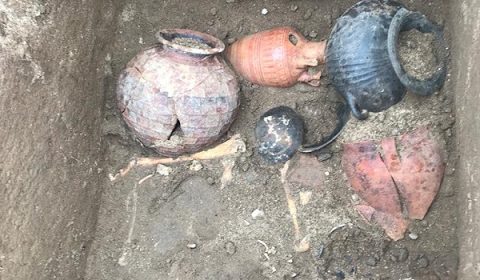Etruscan Tomb Of Child Discovered In Vulci

Etruscan Tomb Of Child Discovered In Vulci
In response to archaeologists, the tomb dates back to the top of the 6th century Bc, and is located a few meters away from the Prince’s Tomb and from the world in query, the place work is being accomplished to boost the Regional Operational Challenge (Progetto operativo regionale) which the Municipality, together with the Lazio region and the Superintendence for the Archaeological Heritage of the Southern Etruria, is finishing up to relaunch the Archaeological and Nature Park of Vulci.
A very powerful object found in the small chamber is a figuline clay amphora painted with geometric motifs with small jugs mounted on the shoulder.
An unusual form that finds an attention-grabbing comparability, even when of a decrease stylistic degree, with an exemplar coming from the so-called Tomb C of Mandrione di Cavalupo, in the present day preserved within the Museum of the Badia di Vulci.
The one different current comparability for this ornamental equipment is a crater, additionally coming from Vulci and exhibited on the Louvre Museum.The funerary monument is of the deep pit kind and comprises a purple tufa sarcophagus.


The lid, rigorously carved from a single monolithic block, has an higher part within the form of a tortoise shell, whereas on the decrease part the recesses used for its placement are nonetheless clearly seen.
The tomb was reused within the Hellenistic age (4th-2nd century BC), when an grownup particular person was positioned on high of the older grave items.
Students imagine that this tomb is said to the princely tomb of the Sphinx, given its shut proximity to the distinctive 27-metre lengthy dromos.


Additionally of specific curiosity is a situla (ingesting vessel) additionally fabricated from figuline clay, this time fully coated with a layer of purple paint.
The grave items, additionally containing small private belongings, point out a male burial as evidenced by the small axe, brief iron spear and an iron knife, in all probability a baby as a result of small dimension of some bones which are in any case burnt because of the cremation ritual to which the small skeleton was subjected about 2,700 years in the past.
“The traditional necropolis of the Osteria is a rare place”, says the Caci, “and it’s definitely an important cultural vacationer attraction that along with the remainder of the park of Vulci makes our territory much more prestigious”.
“This can be a younger member of the rising Etruscan aristocracy of Vulci” explains Carlo Casi, scientific director of the Vulci Basis. “This discovery permits us to unveil one other small piece of the historical past of the primary Etruscans of Vulci and past”.